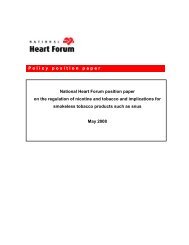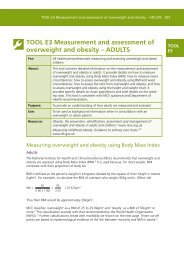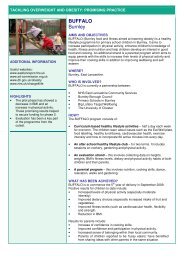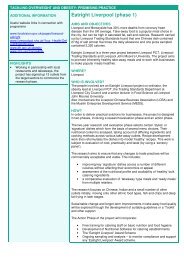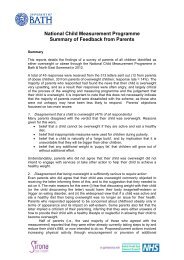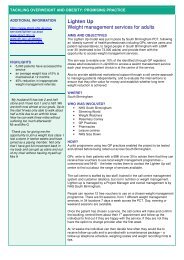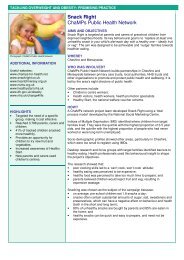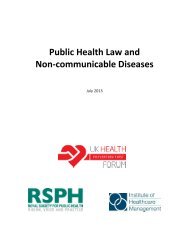The Challenge of Non-Communicable Diseases and Road Traffic ...
The Challenge of Non-Communicable Diseases and Road Traffic ...
The Challenge of Non-Communicable Diseases and Road Traffic ...
Create successful ePaper yourself
Turn your PDF publications into a flip-book with our unique Google optimized e-Paper software.
26 <strong>The</strong> <strong>Challenge</strong> <strong>of</strong> <strong>Non</strong>-communicable <strong>Diseases</strong> <strong>and</strong> <strong>Road</strong> <strong>Traffic</strong> Injuries in Sub-Saharan Africa<br />
major assets for a nation’s development – the 40<br />
percent <strong>of</strong> Africa’s population that now lives in cities<br />
produces 80 percent <strong>of</strong> its GDP – but if not properly<br />
or fairly steered they can lead to major social <strong>and</strong><br />
economic challenges [108]. SSA follows South <strong>and</strong><br />
East Asia in having the third largest number <strong>of</strong> slum<br />
dwellers worldwide, with slum conditions, such as<br />
lack <strong>of</strong> access to basic services, impacting most negatively<br />
on the poorest people, particularly women<br />
<strong>and</strong> children [109-110]. As people move away from<br />
villages, traditional family- or community-based<br />
safety nets are breaking down, <strong>and</strong> governments<br />
are recognizing the need to set up or extend social<br />
protection systems to protect vulnerable households<br />
from sudden shocks to <strong>of</strong>fset poverty [111].<br />
Living in an urban environment is associated with<br />
raised blood pressure, blood sugar, <strong>and</strong> BMI, particularly<br />
for recent settlers, with increased blood<br />
pressure becoming apparent within months <strong>of</strong> migrating<br />
from rural to urban areas [40, 104]. Urban<br />
residents have a 1.5- to fourfold higher prevalence <strong>of</strong><br />
diabetes than their rural counterparts, <strong>and</strong> have increased<br />
cardiovascular risk [34, 112]. Urbanization,<br />
income, sedentary lifestyles, <strong>and</strong> alcohol consumption<br />
independently contribute to higher BMI [113],<br />
<strong>and</strong> changes in dietary habits, stress, <strong>and</strong> uptake <strong>of</strong><br />
smoking among women raise cardiovascular risk<br />
[114-115].<br />
Pollution is an emerging issue in urban centers. It<br />
is caused by emissions from industry, motor vehicles,<br />
<strong>and</strong> households, <strong>and</strong> exacerbated by the use <strong>of</strong><br />
trucks for long-distance transportation in the presence<br />
<strong>of</strong> poor railway systems [116]. <strong>The</strong> use <strong>of</strong> obsolete<br />
vehicles is a major contributor to air pollution,<br />
<strong>and</strong> poor maintenance <strong>of</strong> vehicles <strong>and</strong> monitoring<br />
<strong>and</strong> enforcement systems also contribute to crashes<br />
[63, 117]. Urbanization is associated with increased<br />
asthma prevalence in South Africa <strong>and</strong> other parts<br />
<strong>of</strong> SSA. Unsafe working conditions, out-<strong>of</strong>-date<br />
technology, <strong>and</strong> poor regulation contribute to occupational<br />
lung diseases [118].<br />
<strong>The</strong> Contribution <strong>of</strong> Demographic Change<br />
Africa is undergoing rapid population growth <strong>and</strong><br />
it is likely to double within the coming generation.<br />
Projections are for a population increase from 1.02<br />
billion in 2010 to 1.56 billion in 2030, with around<br />
85 percent <strong>of</strong> his population living in SSA [119]. Figure<br />
12 shows the population distribution by age for<br />
the region in 2010.<br />
FIGURE 12: Population <strong>of</strong> SSA, 2010<br />
Age (years)<br />
80 - 84<br />
70 - 74<br />
60 - 64<br />
50 - 54<br />
40 - 44<br />
30 - 34<br />
20 - 24<br />
10 - 14<br />
0 - 4<br />
10 8 6 4 2 0 2 4 6 8 10<br />
% population (Male = blue; female = red)<br />
Source: [119] (medium variant)<br />
All SSA countries but one (Mauritius) are considered<br />
either high- or medium-fertility countries;<br />
nearly half have an estimated fertility level above<br />
five children per woman. <strong>The</strong>re are signs <strong>of</strong> a fertility<br />
transition to lower rates but this is fairly unpredictable<br />
in SSA countries, <strong>and</strong> depend on the level <strong>of</strong><br />
development, socio-economic factors such as levels<br />
<strong>of</strong> education, female employment, <strong>and</strong> urbanization,<br />
as well as more ‘proximate’ determinants such as<br />
contraceptive use [120]. Countries with the highest<br />
population growth rates struggle to meet the social,<br />
economic, <strong>and</strong> health needs <strong>of</strong> their people, <strong>and</strong> face<br />
increasing environmental stress <strong>and</strong> competition for<br />
l<strong>and</strong> <strong>and</strong> water resources [109].<br />
Africa is the ‘youngest’ region in the world. A demographic<br />
shift which sees half <strong>of</strong> the increase in<br />
world population over the next 40 years in Africa<br />
could be favorable in economic terms, while populations<br />
age elsewhere in the world [1]. However,<br />
youth already comprise up to 60 percent <strong>of</strong> the unemployed<br />
in the region. Investments in education<br />
<strong>and</strong> health are needed to provide skills for jobs, <strong>and</strong><br />
to enhance protection against preventable diseases<br />
that affect productivity <strong>and</strong> the negative impact <strong>of</strong><br />
unemployment on health [121].



